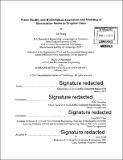Water quality and hydrological assessment and modeling of bioretention basins in tropical cities
Author(s)
Wang, Jia, Ph. D. Massachusetts Institute of Technology
DownloadFull printable version (23.26Mb)
Other Contributors
Massachusetts Institute of Technology. Department of Civil and Environmental Engineering.
Advisor
Peter Shanahan and Lloyd H.C Chua.
Terms of use
Metadata
Show full item recordAbstract
The bioretention basin is a form of stormwater best management practice that originated in temperate regions and is becoming increasingly popular in tropical regions. Nevertheless, it is a poorly evaluated system in the tropics due to the limited availability of long-term, high-resolution hydrological and multi-component water quality data on completed basins. The resulting gaps in data and knowledge limit the ability of environmental managers to control nonpoint source pollution by stormwater. In this thesis, we provide a survey of basin performance in treating 15 water quality parameters in the Balam Estate Rain Garden in Singapore. We then use a combination of field observations and model simulations to recommend practical engineering strategies to design and manage bioretention basins in the tropics. First, field observations on water quality performance in six sampled events show that removal targets for total nitrogen, total phosphorus, and total suspended solids are generally met only for low-depth rainfall events and not high-depth events. We attribute this to the low influent event mean concentration and weak first flush resulting from the frequent and intense rainfall of the tropical climate. Second, field observations on hydrological performance in 80 events show that a lack of storage capacity and resulting high culvert overflow is the main driver in reducing removal efficiency for large, but still common, storm events. We recommend that design guidelines in the tropics be specified in terms of the more definitive quantity, water quality depth (WQD), instead of average return interval (ARI). Third, we investigate design configurations for improved hydrological performance efficiency by first demonstrating the applicability of the RECHARGE numerical hydrological model for continuous simulation over a half-year period at the field scale. Sensitivity analysis using the model suggests design configurations that improve basin hydrological performance. Lastly, we develop a process-based numerical water quality model using the mathematical formulations from CW2D to describe the bacterial dynamics in contributing to nitrogen removal in the subsurface soil media. Sensitivity analysis using the model produces bioretention basin design curves that are suitable for the tropics.
Description
Thesis: Ph. D., Massachusetts Institute of Technology, Department of Civil and Environmental Engineering, 2017. Cataloged from PDF version of thesis. Includes bibliographical references (pages 232-242).
Date issued
2017Department
Massachusetts Institute of Technology. Department of Civil and Environmental EngineeringPublisher
Massachusetts Institute of Technology
Keywords
Civil and Environmental Engineering.